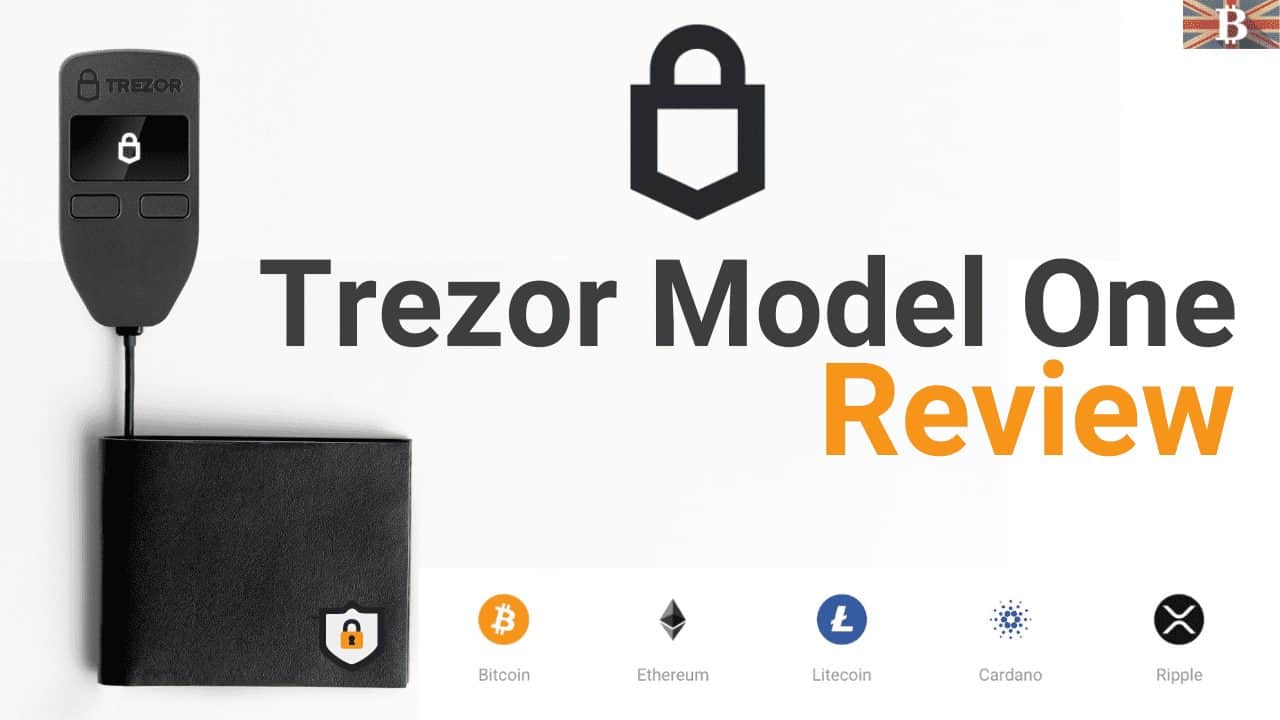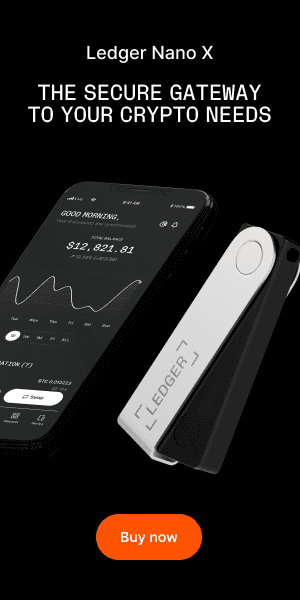In this Trezor One review for 2023, we take a deep dive into the popular Trezor One hardware wallet. Exploring the wallet’s pros, cons, cryptocurrencies it supports, features, price and how it compares to others on the market.
Crypto hardware wallets are a great way to secure your crypto assets, especially with so much risk from cyberattacks. When you store crypto keys and security details online, they are at risk from criminals. That risk is reduced when these are stored offline in a hardware wallet. Keeping your crypto funds safe.
So, let’s dive into this Trezor One Review to help you work out whether the Model One is the right wallet for you.
Trezor One Review: How to Set up a Trezor One

Trezor One Pros & Cons
- Supports over 1,000 coins and tokens
- Low Entry Price
- Easy to Use
- Small & Lightweight device
- iOS and Windows Phone Not Supported
- Some major tokens not supported
What is Trezor?
SatoshiLabs, a crypto and blockchain-based company in the Czech Republic, created Trezor. Founded over 9 years ago, Trezor and SatoshiLabs now have a wide range of consumer products, such as hardware wallets and blockchain-based projects they have created and launched.
Trezor was the first hardware wallet to launch on the market. The founders of SatoshiLabs, Marek and Pavol, realised they were experiencing the same problem: trying to keep private keys and crypto assets safe from cybercriminals and opportunistic hackers.
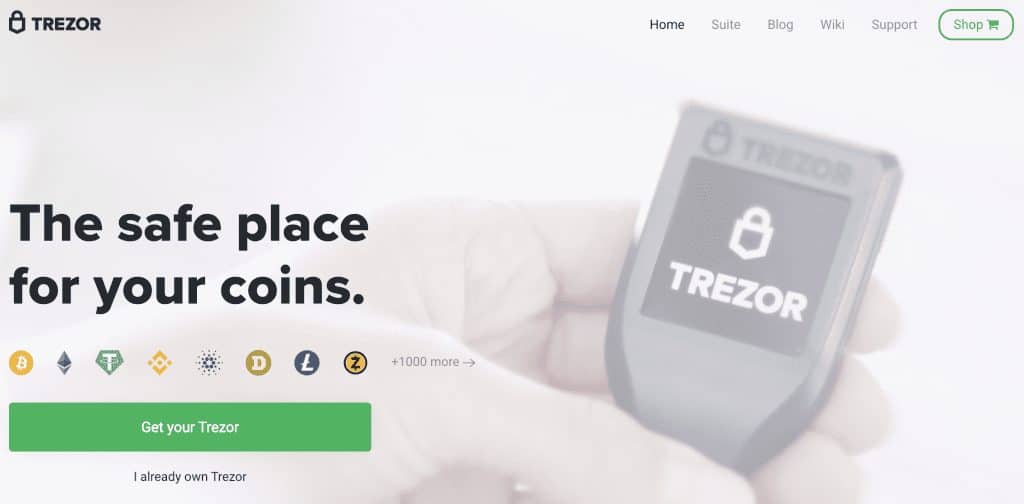
In 2012, they developed a prototype of a hardware wallet, which became the Trezor Model T.
After raising investment in 2016, SatoshiLabs started designing something that was easy to use for consumers. Two years later, in 2018, the first Trezor Model Ts started to go on sale, named after Henry Ford’s Model T car, the world’s first affordable consumer vehicle, introduced to the world in 1908.
Now in 2022, SatoshiLabs has a team of over 95 worldwide, and Trezor hardware wallets are supported or sold in 220 countries and territories. The Model One and a range of hardware wallet accessories were launched as part of this range.
Trezor is promoted as “The original cryptocurrency hardware wallet”, a SatoshiLabs product, the Czech Republic-based “inventors of Trezor.”
What is a Hardware Wallet?
Until hardware wallets came along, everything crypto-related was stored online. That was a significant problem considering the high risk of cyber attacks, hacks, and data theft. Especially when so much within the crypto world is built using open-source software. This means that the code that makes crypto exchanges and wallets work is available online for anyone to view.
This information is usually used to create new products, services, and apps. However, this also means the code can be used by cybercriminals to find ways into people’s wallets and security details and hack into crypto exchanges.
A hardware wallet solves the most serious aspect of this security problem. This is because the details you need to access your crypto funds are stored offline, sometimes known as being in “cold storage.” Also, they can’t be hacked because these details are on a hardware device, not accessible to the online world.
Owning a hardware wallet like the Trezor One solves this problem and keeps your secure key, passphrase, codes, and other details safe.
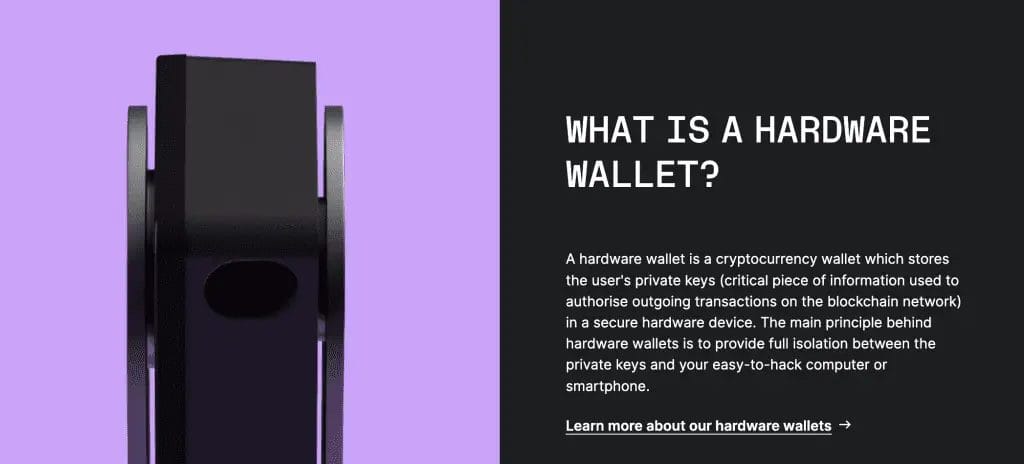
What is the Trezor One?
Trezor One is Trezor’s second hardware wallet to go on the market, after the Trezor Model T.
It comes complete with access to the same password management and recovery suite, and although it is a watered-down version of the Model T, it still comes with much of the same security features.
As with any hardware wallet, the first thing you need to do is create a “recovery seed.” This is a security phrase, between 12 and 24 words long. Write it down and store it safely (offline). If you ever lose or break your device, this recovery seed will restore access to your assets.
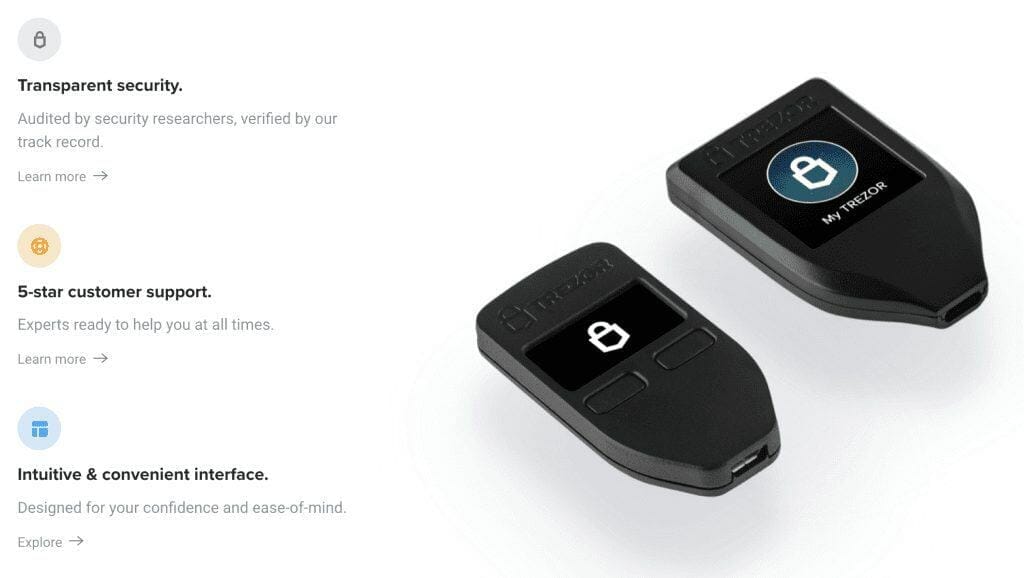
Trezor supports over a thousand cryptocurrencies and tokens, although the One doesn’t support quite as many as the Model T. All of these and your passwords can be managed online in the Trezor Suite and Password Suite. Both are secure and encrypted cloud-based systems for managing your crypto-related passwords and secure keys, and crypto funds.
What’s in the Box?
- Trezor Model One – Black
- Micro USB cable
- 2x Recovery seed card
- Trezor stickers
Trezor Model One: Specifications
- A Bright OLED, 128×64 pixels screen, with enough space for six lines of text. Trezor says, “Can display all the details needed to verify a transaction on a single screen.”
- Password and crypto asset management through the Trezor Suite and Password Suite
- Secure access using a PIN, with the option for a passphrase, only when connected to a computer, not through the device directly
- Numerous layers of encryption and authentication (2-Factor, SSH, GPG)
- Premium European-based support is provided (more on that below)
- Thousands of cryptocurrencies and tokens are also supported (more on that below, too)
- Size: 60mm x 30mm x 6mm (2.4in x 1.2in x 0.2in)
- Weight: 12 g (0.42 oz)
- It comes with a USB to connect to a phone or computer
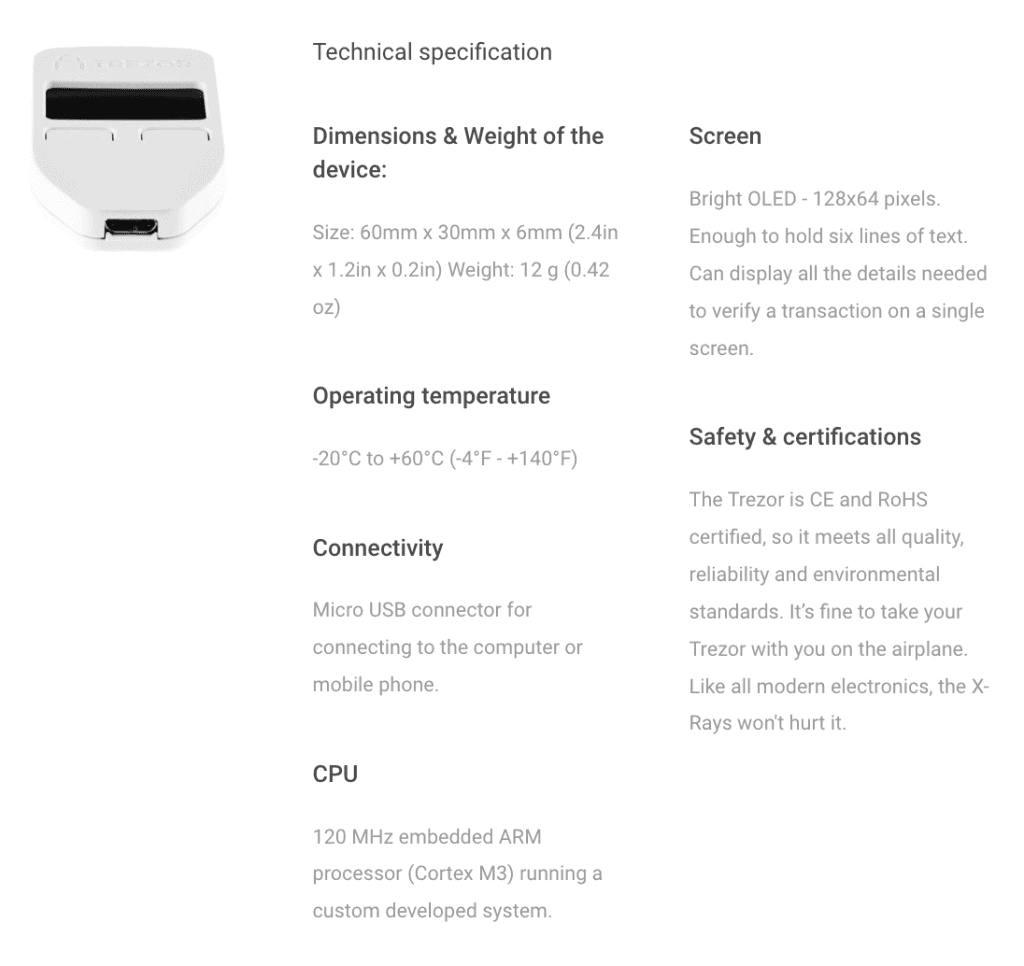
Trezor One Supported Cryptocurrencies
Although the Model T currently supports 1,816 cryptocurrencies, tokens, and stablecoins (out of 5,500+ currently in existence), the Trezor One doesn’t support quite as many. Most, just not all, given it’s a more lightweight version of the Model T.
All of the most popular cryptocurrencies and tokens are supported, of course, including Bitcoin (BTC), Ethereum (ETH), Binance Coin (BNB), Tether (USDT), Ripple (XRP), and many more.
Take a look at all of the cryptocurrencies Trezor supports here, with a tick next to those the One supports.

Trezor Suite
When you own a Trezor hardware wallet like the One, you need a way to manage your crypto and security passwords. You can do this through the Trezor Suite, a desktop-based app (available on Mac, Windows, and Linux devices). Unfortunately, it’s not available for smartphones, or at least it isn’t yet; it might be in the future. Within its many features, you can use it to buy, exchange and spend cryptocurrencies, altcoins, and stablecoins.
How Much Does a Trezor One Cost?
The Trezor One is significantly cheaper than the Model T, currently retailing for €82.80 (with €10 in shipping), compared to €226.80 for the Model T. So, for customers in the UK, that comes to around £68.00, at the current exchange rates, and $89.00 in U.S. Dollars.
We will compare how that stacks up against other hardware wallets a little later in this article.

Trezor Discounts
A quick search for Trezor One discount code shows there are dozens of them online. It might be worth checking with Trezor if they are valid before using one (either via social media or Help Center).
Trezor also offers discounts and offers to affiliates, resellers, and on certain online sales days, such as Black Friday and Cyber Monday. Keep an eye out for deals and promotions from Every Bit Helps on Trezor hardware wallets, including the Trezor One.
How does Trezor Compare
With so many hardware wallets around, it’s worth comparing the options to see which offers the best features and value for money. Let’s look at how the Trezor One compares against the Trezor Model T and competitors, such as the Ledger, BitBox02 and Keeve.
Trezor One vs. Trezor Model T
As the Trezor One and Trezor Model T come from the same family of hardware devices, we can expect numerous similarities. Both are protected with the same layers of security and encryption, and both support roughly the same number of cryptocurrencies (with the One not able to support quite as many).
The major differences come down to how easily you can use each device. The Model T has a full-colour touchscreen. Whereas the One needs a USB connection to a laptop or phone to work, with security details verified on the screen using the buttons provided. Beyond that, security keys and crypto can be managed using the same suite of software tools: Trezor Suite and Password Suite.
As the Trezor One is more lightweight, it’s much cheaper. It costs €82.80, compared to €226.80 for the Model T. All in all, more affordable but not quite as versatile.
Trezor One vs. Ledger Nano S
The Ledger Nano S is a Ledger hardware device, a company that attempted to get into the same game as Trezor. Ledger is equally, if not more so, security-focused. Ledger doesn’t just sell hardware wallets; the proprietary software and operating systems they’ve created support and strengthen numerous companies’ security in the crypto and blockchain-based sectors.
Unlike the Trezor Model T and Ledger Nano X, the Nano S is a comparable device. Similar in size, price, and functionality. However, the Nano S supports more cryptocurrencies: around 5,000, compared to the 1,000+ that Trezor One can manage. Plus, you can download 3 crypto-based apps on the Ledger Nano S.
The Ledger Nano S is also cheaper, available on sale for £54.50 (around $70), and comes in a range of colours: black, orange, pink, green, blue, and transparent (grey). In comparison, the Trezor One is €82.80 (around £68.00, or $89.00).
You can also make savings by purchasing bundles with the Nano S. An impressive 21% saving when you buy three or more.
Trezor Support
The team make sure their customers are supported, even if you’ve bought a hardware wallet through an affiliate or partner. Trezor provides a Help Center, complete with separate areas for technical and shipping questions, an FAQ, a user manual, and access to the community of Trezor customers. You can contact them directly using social media or raise a support ticket.
Customer support is 5-star rated, so you should expect a quick and helpful response.
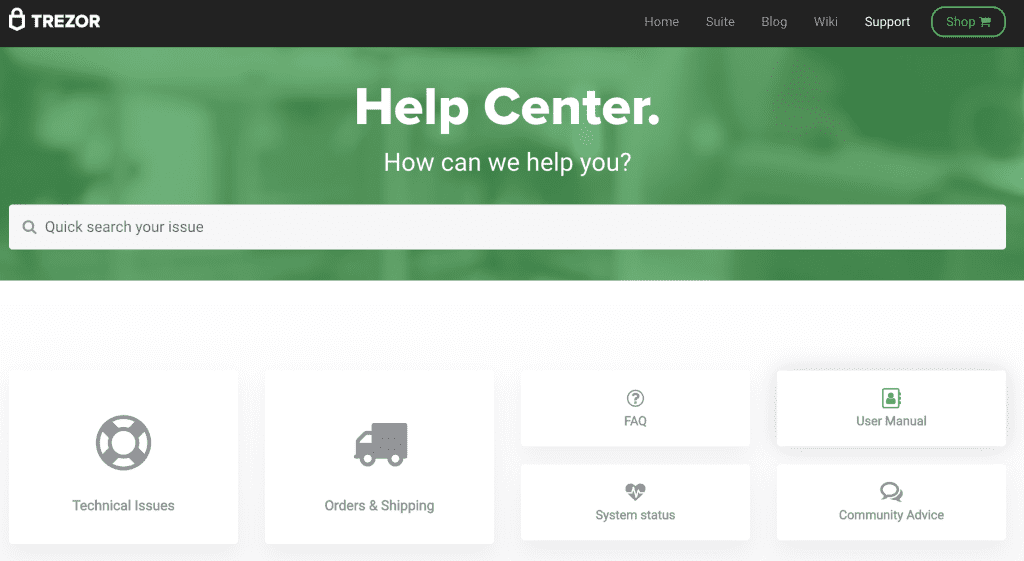
Trezor Security
Trezor takes security seriously, especially with the hardware wallets they sell. Every security effort they’ve made for the One and Model T hardware wallet is outlined here on this page. Trezor uses numerous layers of encryption and security safeguards within the software, hardware, and firmware.

Are Trezor Hardware Wallets Safe?
Yes, Trezor hardware wallets are as safe as other crypto hardware wallets. Trezor has taken a transparent approach to security, listing every issue users have encountered (and any attempted hacks and cyber breaches) here.
So far, since Trezor launched the Model T in 2018, there have been 23 issues encountered (encompassing those the One has experienced too). Hardly unusual for hardware or software companies (and Trezor is both), but it’s encouraging to see a company be transparent about this.

Verdict: Should you buy a Trezor One?
For those wanting an affordable, easy-to-use, and secure hardware wallet, the Trezor One is a good purchase. It’s reliable and safe, and millions around the world are already using it or the Model T to keep their crypto assets secure.
However, if you can afford the Trezor Model T, I would personally go for the Model T over Trezor One.
We hope you found our Trezor One review useful; if you already own a Trezor, let us know what you think in the comments below. If you want to purchase a Trezor wallet, make sure you purchase one from the official Trezor store.

